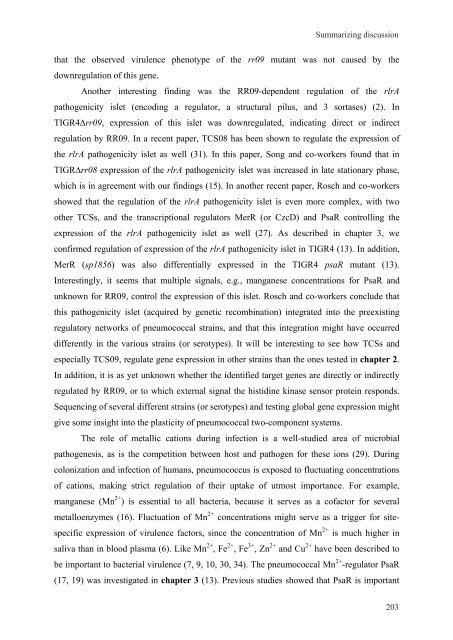Gene regulation in Streptococcus pneumoniae - RePub - Erasmus ...
Gene regulation in Streptococcus pneumoniae - RePub - Erasmus ...
Gene regulation in Streptococcus pneumoniae - RePub - Erasmus ...
Create successful ePaper yourself
Turn your PDF publications into a flip-book with our unique Google optimized e-Paper software.
that the observed virulence phenotype of the rr09 mutant was not caused by the<br />
down<strong>regulation</strong> of this gene.<br />
Summariz<strong>in</strong>g discussion<br />
Another <strong>in</strong>terest<strong>in</strong>g f<strong>in</strong>d<strong>in</strong>g was the RR09-dependent <strong>regulation</strong> of the rlrA<br />
pathogenicity islet (encod<strong>in</strong>g a regulator, a structural pilus, and 3 sortases) (2). In<br />
TIGR4∆rr09, expression of this islet was downregulated, <strong>in</strong>dicat<strong>in</strong>g direct or <strong>in</strong>direct<br />
<strong>regulation</strong> by RR09. In a recent paper, TCS08 has been shown to regulate the expression of<br />
the rlrA pathogenicity islet as well (31). In this paper, Song and co-workers found that <strong>in</strong><br />
TIGR∆rr08 expression of the rlrA pathogenicity islet was <strong>in</strong>creased <strong>in</strong> late stationary phase,<br />
which is <strong>in</strong> agreement with our f<strong>in</strong>d<strong>in</strong>gs (15). In another recent paper, Rosch and co-workers<br />
showed that the <strong>regulation</strong> of the rlrA pathogenicity islet is even more complex, with two<br />
other TCSs, and the transcriptional regulators MerR (or CzcD) and PsaR controll<strong>in</strong>g the<br />
expression of the rlrA pathogenicity islet as well (27). As described <strong>in</strong> chapter 3, we<br />
confirmed <strong>regulation</strong> of expression of the rlrA pathogenicity islet <strong>in</strong> TIGR4 (13). In addition,<br />
MerR (sp1856) was also differentially expressed <strong>in</strong> the TIGR4 psaR mutant (13).<br />
Interest<strong>in</strong>gly, it seems that multiple signals, e.g., manganese concentrations for PsaR and<br />
unknown for RR09, control the expression of this islet. Rosch and co-workers conclude that<br />
this pathogenicity islet (acquired by genetic recomb<strong>in</strong>ation) <strong>in</strong>tegrated <strong>in</strong>to the preexist<strong>in</strong>g<br />
regulatory networks of pneumococcal stra<strong>in</strong>s, and that this <strong>in</strong>tegration might have occurred<br />
differently <strong>in</strong> the various stra<strong>in</strong>s (or serotypes). It will be <strong>in</strong>terest<strong>in</strong>g to see how TCSs and<br />
especially TCS09, regulate gene expression <strong>in</strong> other stra<strong>in</strong>s than the ones tested <strong>in</strong> chapter 2.<br />
In addition, it is as yet unknown whether the identified target genes are directly or <strong>in</strong>directly<br />
regulated by RR09, or to which external signal the histid<strong>in</strong>e k<strong>in</strong>ase sensor prote<strong>in</strong> responds.<br />
Sequenc<strong>in</strong>g of several different stra<strong>in</strong>s (or serotypes) and test<strong>in</strong>g global gene expression might<br />
give some <strong>in</strong>sight <strong>in</strong>to the plasticity of pneumococcal two-component systems.<br />
The role of metallic cations dur<strong>in</strong>g <strong>in</strong>fection is a well-studied area of microbial<br />
pathogenesis, as is the competition between host and pathogen for these ions (29). Dur<strong>in</strong>g<br />
colonization and <strong>in</strong>fection of humans, pneumococcus is exposed to fluctuat<strong>in</strong>g concentrations<br />
of cations, mak<strong>in</strong>g strict <strong>regulation</strong> of their uptake of utmost importance. For example,<br />
manganese (Mn 2+ ) is essential to all bacteria, because it serves as a cofactor for several<br />
metalloenzymes (16). Fluctuation of Mn 2+ concentrations might serve as a trigger for sitespecific<br />
expression of virulence factors, s<strong>in</strong>ce the concentration of Mn 2+ is much higher <strong>in</strong><br />
saliva than <strong>in</strong> blood plasma (6). Like Mn 2+ , Fe 2+ , Fe 3+ , Zn 2+ and Cu 2+ have been described to<br />
be important to bacterial virulence (7, 9, 10, 30, 34). The pneumococcal Mn 2+ -regulator PsaR<br />
(17, 19) was <strong>in</strong>vestigated <strong>in</strong> chapter 3 (13). Previous studies showed that PsaR is important<br />
203<br />
203

















